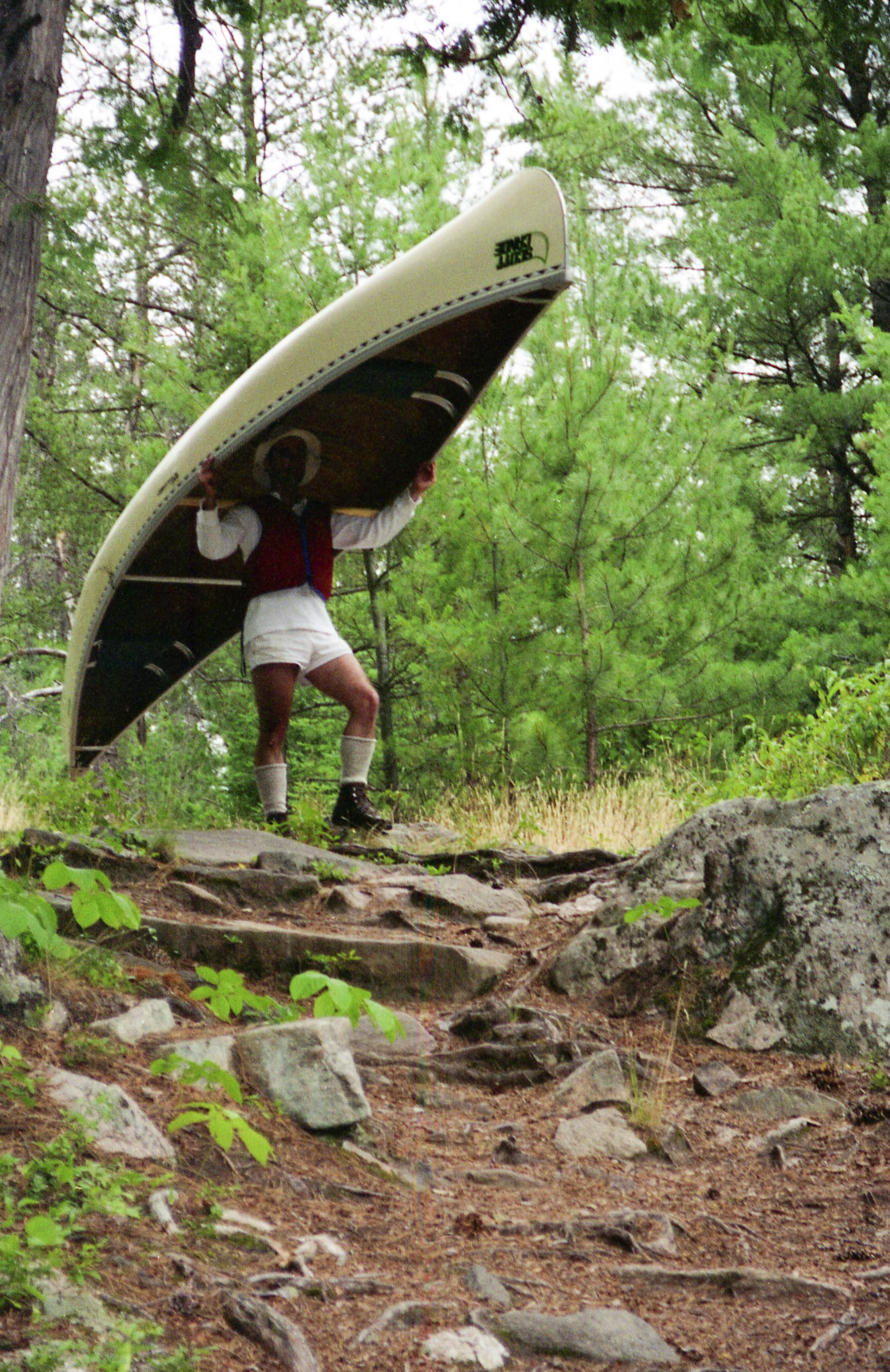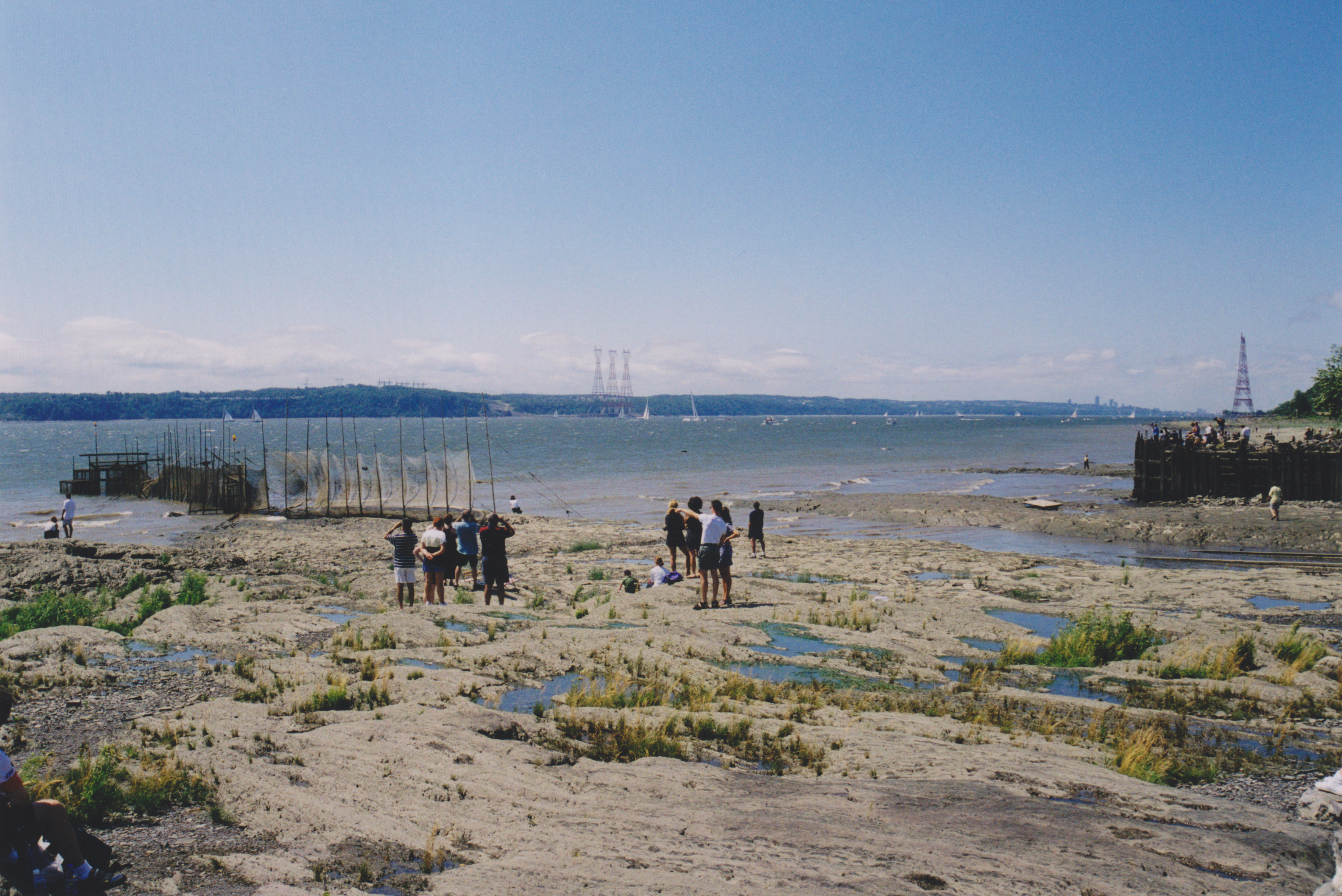|
Fox–Wisconsin Waterway
The Fox–Wisconsin Waterway is a waterway formed by the Fox and Wisconsin Rivers. First used by European settlers in 1673 during the expedition of Marquette & Joliet, it was one of the principal routes used by travelers between the Great Lakes and the Mississippi River until the completion of the Illinois and Michigan Canal in 1848 and the arrival of railroads. The western terminus of the Fox–Wisconsin Waterway was at the Mississippi at Prairie du Chien, Wisconsin. It continued up the Wisconsin River about until reaching Portage, Wisconsin. There travelers would portage to the Upper Fox River, or eventually, use the Portage Canal. It continued about down the Fox River, following it through Lake Winnebago and continuing on the Lower Fox over 170 feet (50 m) of falls to the eastern terminus of Green Bay. In the mid-19th century, the waterway was improved with numerous locks, dams and canals, including the Portage Canal between the Fox and Wisconsin Rivers. All the locks were ... [...More Info...] [...Related Items...] OR: [Wikipedia] [Google] [Baidu] |
Portage Wisconsin Aerial View
Portage or portaging (Canadian English, CA: ; ) is the practice of carrying water craft or cargo over land, either around an obstacle in a river, or between two bodies of water. A path where items are regularly carried between bodies of water is also called a ''portage.'' The term comes from French, where means "to carry", as in "portable". In Canada, the term "carrying-place" was sometimes used. Early French explorers in New France and Louisiana (New France), French Louisiana encountered many rapids and Fan waterfalls, cascades. The Indigenous peoples of the Americas, Native Americans carried their canoes over land to avoid river obstacles. Over time, important portages were sometimes provided with canals with canal lock, locks, and even portage railways. Primitive portaging generally involves carrying the vessel and its contents across the portage in multiple trips. Small canoes can be portaged by carrying them inverted over one's shoulders and the center thwart, strut may be ... [...More Info...] [...Related Items...] OR: [Wikipedia] [Google] [Baidu] |
Winnebago Pool
The Winnebago Pool is a collective name for a group of interconnected lakes in eastern Wisconsin. The terminal point of this watershed is Lake Winnebago itself, which has a surface elevation of 746 feet. Besides Lake Winnebago, the Winnebago Pool includes Big Lake Butte des Morts, Lake Poygan and Lake Winneconne. After the waters reach Lake Winnebago, they exit through the Lower Fox River and over the next 39 miles, the river drops over 150 feet to reach the lower water level of Green Bay. The lakes of the Winnebago pool combine to encompass over and account for nearly 17% of the total surface water area in Wisconsin (not counting the Great Lakes The Great Lakes, also called the Great Lakes of North America, are a series of large interconnected freshwater lakes spanning the Canada–United States border. The five lakes are Lake Superior, Superior, Lake Michigan, Michigan, Lake Huron, H ...). The primary feed waters of the Winnebago Pool are the Wolf River, Upper F ... [...More Info...] [...Related Items...] OR: [Wikipedia] [Google] [Baidu] |
Fox Wars
The Fox Wars were two conflicts between the French and the Meskwaki (historically Fox) people who lived in the Great Lakes region (particularly near Fort Pontchartrain du Détroit) from 1712 to 1733.In their book ''The Fox Wars'', Edmunds and Peyser discuss the difficulties in nomenclature, saying, "They referred to themselves as Mesquakies, as do the modern Mesquakie people near Tama, Iowa. In the late seventeenth and early eighteenth centuries, however, other Algonquian tribes of the western Great Lakes region and upper Mississippi Valley frequently called them Outagami, using a Chippewa word meaning ‘People of the Opposite Shore.’ In contrast, the French almost always referred to the Mesquakies as Renards, or ‘Foxes.’ Almost 90 percent of the anthropological and historical references to the tribe also use the term Fox…since most anthropologists and historians use the term Fox, as do most library reference systems, we finally decided generally to use Fox when discussin ... [...More Info...] [...Related Items...] OR: [Wikipedia] [Google] [Baidu] |
Great Lakes
The Great Lakes, also called the Great Lakes of North America, are a series of large interconnected freshwater lakes spanning the Canada–United States border. The five lakes are Lake Superior, Superior, Lake Michigan, Michigan, Lake Huron, Huron, Lake Erie, Erie, and Lake Ontario, Ontario (though hydrologically, Lake Michigan–Huron, Michigan and Huron are a single body of water, joined at the Straits of Mackinac). The Great Lakes Waterway enables modern travel and shipping by water among the lakes. The lakes connect to the Atlantic Ocean via the Saint Lawrence River, and to the Mississippi River basin through the Illinois Waterway. The Great Lakes are the largest group of freshwater lakes on Earth by total area and the second-largest by total volume. They contain 21% of the world's surface fresh water by volume. The total surface is , and the total volume (measured at the low water datum) is , slightly less than the volume of Lake Baikal (, 22–23% of the world's surface f ... [...More Info...] [...Related Items...] OR: [Wikipedia] [Google] [Baidu] |
St Lawrence River
The St. Lawrence River (, ) is a large international river in the middle latitudes of North America connecting the Great Lakes to the North Atlantic Ocean. Its waters flow in a northeasterly direction from Lake Ontario to the Gulf of St. Lawrence, traversing Ontario and Quebec in Canada and New York in the United States. A section of the river demarcates the Canada–U.S. border. As the primary drainage outflow of the Great Lakes Basin, the St. Lawrence has the second-highest discharge of any river in North America (after the Mississippi River) and the 16th-highest in the world. The estuary of the St. Lawrence is often cited by scientists as the largest in the world. Significant natural landmarks of the river and estuary include the 1,864 river islands of the Thousand Islands, the endangered whales of Saguenay–St. Lawrence Marine Park, and the limestone monoliths of the Mingan Archipelago. Long a transportation route to Indigenous peoples, the St. Lawrence River has ... [...More Info...] [...Related Items...] OR: [Wikipedia] [Google] [Baidu] |
French And Indian War
The French and Indian War, 1754 to 1763, was a colonial conflict in North America between Kingdom of Great Britain, Great Britain and Kingdom of France, France, along with their respective Native Americans in the United States, Native American allies. European historians generally consider it a related conflict of the wider 1756 to 1763 Seven Years' War, although in the United States it is viewed as a singular conflict unassociated with any European war. Although Britain and France were officially at peace following the Treaty of Aix-la-Chapelle (1748), tensions over trade continued in North America. These culminated in a dispute over the Forks of the Ohio, and the related French Fort Duquesne which controlled them. In May 1754, this led to the Battle of Jumonville Glen, when Colony of Virginia, Virginia militia led by George Washington ambushed a French patrol. In 1755, Edward Braddock, the new Commander-in-Chief, North America, planned a four-way attack on the French. None s ... [...More Info...] [...Related Items...] OR: [Wikipedia] [Google] [Baidu] |
Menominee
The Menominee ( ; meaning ''"Menominee People"'', also spelled Menomini, derived from the Ojibwe language word for "Wild Rice People"; known as ''Mamaceqtaw'', "the people", in the Menominee language) are a federally recognized tribe of Native Americans officially known as the Menominee Indian Tribe of Wisconsin. Their land base is the Menominee Indian Reservation in Wisconsin. Their historic territory originally included an estimated in present-day Wisconsin and the Upper Peninsula of Michigan. The tribe currently has about 8,700 members. Federal recognition of the tribe was terminated in the 1960s under policy of the time which stressed assimilation. During that period, they brought what has become a landmark case in Indian law to the United States Supreme Court, in '' Menominee Tribe v. United States'' (1968), to protect their treaty hunting and fishing rights. The Wisconsin Supreme Court and the United States Court of Claims had drawn opposing conclusions about ... [...More Info...] [...Related Items...] OR: [Wikipedia] [Google] [Baidu] |
Illinois
Illinois ( ) is a U.S. state, state in the Midwestern United States, Midwestern United States. It borders on Lake Michigan to its northeast, the Mississippi River to its west, and the Wabash River, Wabash and Ohio River, Ohio rivers to its south. Of the fifty U.S. states, Illinois has the List of U.S. states and territories by GDP, fifth-largest gross domestic product (GDP), the List of U.S. states and territories by population, sixth-largest population, and the List of U.S. states and territories by area, 25th-most land area. Its capital city is Springfield, Illinois, Springfield in the center of the state, and the state's largest city is Chicago in the northeast. Present-day Illinois was inhabited by Indigenous peoples of the Americas#History, Indigenous cultures for thousands of years. The French were the first Europeans to arrive, settling near the Mississippi and Illinois River, Illinois rivers in the 17th century Illinois Country, as part of their sprawling colony of ... [...More Info...] [...Related Items...] OR: [Wikipedia] [Google] [Baidu] |
Rock River (Mississippi River)
The Rock River is a tributary of the Mississippi River, approximately long,U.S. Geological Survey. National Hydrography Dataset high-resolution flowline dataThe National Map accessed May 13, 2011 in the U.S. states of Wisconsin and Illinois. The river was known as the Sinnissippi to the Sauk and Meskwaki peoples; the name means "rocky waters". The river, which has a notable higher western bank, begins with three separate branches that flow into the Horicon Marsh. The northernmost branch, the West Branch, begins just to the west of the village of Brandon in Fond du Lac County, Wisconsin and flows east and then south to Horicon Marsh. The South Branch rises north of Fox Lake in Dodge County and flows east through Waupun to the marsh. The East Branch rises southeast of Allenton in Washington County just west of the Niagara Escarpment, and flows north and west through Theresa to the marsh. Leaving the marsh, it meanders southward to the Illinois border, ending about 300 mile ... [...More Info...] [...Related Items...] OR: [Wikipedia] [Google] [Baidu] |
Niagara Falls
Niagara Falls is a group of three waterfalls at the southern end of Niagara Gorge, spanning the Canada–United States border, border between the Provinces and territories of Canada, province of Ontario in Canada and the state of New York (state), New York in the United States. The largest of the three is Horseshoe Falls, which straddles the Canada–United States border, international border of the two countries. It is also known as the Canadian Falls. The smaller American Falls and Bridal Veil Falls (Niagara Falls), Bridal Veil Falls lie within the United States. Bridal Veil Falls is separated from Horseshoe Falls by Goat Island (New York), Goat Island and from American Falls by Luna Island, with both islands situated in New York. Formed by the Niagara River, which drains Lake Erie into Lake Ontario before flowing out to the Atlantic Ocean through the St. Lawrence River, the combined falls have the List of waterfalls by flow rate, highest flow rate of any waterfall in North ... [...More Info...] [...Related Items...] OR: [Wikipedia] [Google] [Baidu] |








